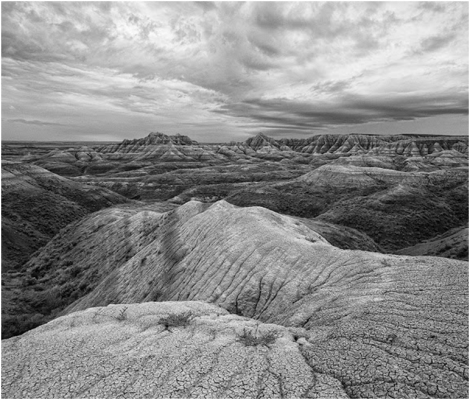 Moving forward always gives a better view to the past. As I get set to move after a decade in one place, all the years of field photography, and especially the resulting images, now come to the forefront with different thoughts and emotions attached. The images that have special merit are the ones that have found their way into my heart and then onto my walls. They have literally stood the test of time, Now, as I move them to a new setting, I can’t help but reflect upon those special moments when I captured them.
Moving forward always gives a better view to the past. As I get set to move after a decade in one place, all the years of field photography, and especially the resulting images, now come to the forefront with different thoughts and emotions attached. The images that have special merit are the ones that have found their way into my heart and then onto my walls. They have literally stood the test of time, Now, as I move them to a new setting, I can’t help but reflect upon those special moments when I captured them.
Some moments and places are easier to recall than others, Some seem, like a distant Bob Dylan song, suspended in time. All the images have meaning to me. And, like every serious photographer, I hope others might find something worth their attention. Of the twenty or so images displayed in the house here, these four have become favorites.
The image above was taken from the north rim of the Grand Canyon as I enjoyed the awesome experience of watching a thunderstorm over Cape Royal. I realize that, after my move from Arizona to Nevada, I’m going to be less likely to travel the south rim and better situated to visit the north rim. This image becomes a beacon drawing me closer to vistas and settings I’ve not yet explored. Cape Royal marks the point where the Colorado River starts its east to west flow. The point is vast and open and an adventure to get to. The north rim is only open to vehicles in the mild months making photography there even more special.
In this image the passing storm was distant and when it did make its way down canyon the show only lasted a few minutes. No moisture came within a mile or so and the color of the sunset was only intense for a few seconds. As it passed I made only a few frames and then quickly went to a wide format camera to capture a couple watching the sunset while sitting just outside of the frame to the right. Both images were successful but this one reveals the vibrancy and luminosity of the storm. It was taken with the Singh-Ray LB ColorCombo and 4-stop hard-step Graduated ND filter.
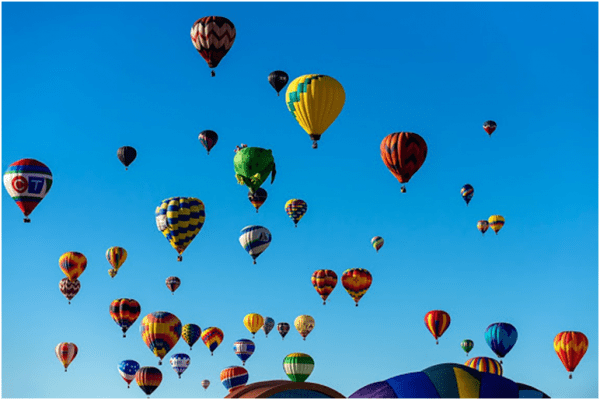
The new location will put me only two hours from Death Valley National Park. This is the first place I explored in depth in the 1960’s and the place that inspired me to learn the art of photography. It’s also the place that my first workshop took place so many years ago! There is no place that compares to its wide open vistas, vast expanses, geology and light. This is simply the place that started it all for me and the place that promises untold images to come. Here I’m at home and at peace with the planet!
The Racetrack playa and its sliding rocks hold mystery and intrigue. All those who come here quickly come under the spell of “how and when?” Since no one has actually seen them move there are many theories on how they do it, but one thing is perfectly clear, they do move! To miss this beautiful dry lake is a mistake, and through the years my most successful images have shown the habitat of the rocks and the length and depth of the tracks they make as they move. I’ve always been in awe when at sunset the playa reflects in subtle shades the color of the sky. The reflected light gives a glow that leads the eye to the horizon. It always requires some thought to properly expose and use my filters, but when I get it right, the world out there ‘explodes.’ I used a Singh-Ray LB Color Intensifier along with a 4-stop soft-step ND Grad.

The magical slots of Antelope Canyon have intrigued and drawn me since the 1980’s. After many years of photographing these cathedrals of sandstone, I’ve discovered that the light is drastically changed by the seasons and the slot canyons are always changing as the frequent flash floods continually sculpt them. Sometimes the floor brings you different angles and views as it rises and falls through the years. It’s simply never the same setting or feel twice!
This scene no longer exists, but I do look for it every time I visit. The glorious effects of the reflected light was what brought me to it in the first place. The arch of the lines and the muted color in the lower portion is what sets the composition. The lines did not run far and the composition became muddled very quickly. Getting the exposure right for the foreground rocks was the key. Today this image is 20×30 on my wall.
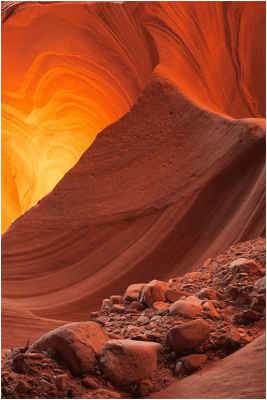
This is the matching bookend to the image above. It was also taken in the slot canyons. I’ve always used this image as an example of what timing and planning can do. In the summer months in this area, the slot canyons are jammed with tourists and photographers. Fighting for any space, let alone tripod space, can be an issue. Here there were at least 50 people in this area when the image was made.
How was it possible? Our guides who brought our group to this spot just before the light appeared asked all others either behind or in front of us to give us a few minutes to shoot this wonderful image. It took no more than 90 seconds for each of us to capture our own version of this magnificent setting! It was taken with the Color Intensifier plus a 3-stop soft-step ND grad which was used ‘sideways’ to balance the much brighter left side of the frame.
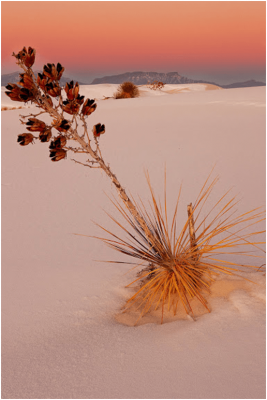
This is the newest of the images shown here. The setting is unique in that it was only available for a few hours after a snow storm hit the White Sands National Monument. Usually the white gypsum sand is the attraction, but here I had the opportunity to show the texture in both the sand and the snow. The fading light of dusk brought the winter glow but as the light dissipated it became very faint. The problem was solved with the use of LB ColorCombo’s polarizing feature. The camera angle was chosen to take full advantage of the polarizing effect.
First I lengthened the exposure to bring the 18 percent gray up two stops to compensate for the white sand and snow. To reduce the chance of movement in the 20-second exposure, I shot frames until the light had completely gone. I alternated between several of my ND Grads as I made the exposures. Several were acceptable and today this is the largest vertical image I’ve hung. I’ve not yet decided its place of prominence in the new setting, but even the thought is inspiring.
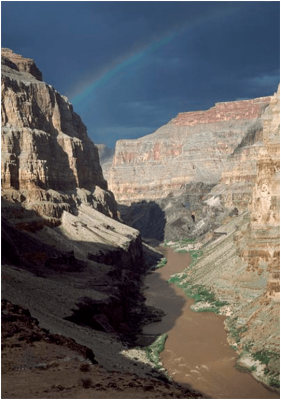
This is the oldest image I still show. Done on a unplanned expedition into the lower granite gorge of the Grand Canyon in the 1980’s, this accident of an image is still very much etched in my heart and soul. After camping along the river, we were heading back up to the rim when we saw this storm all around us. The strange thing was that we never even felt a breeze. When we had almost completed the ride back up to the rim, the rainbow appeared and the shoot was on! At the time the only Singh-Ray filters I owned were the 2-stop soft-step and 3-stop hard-step ND Grads. I made use of both of them. Because I was using film, the shadow area was particularly tough to expose properly. I remember bracketing wildly as the good light came and then went quickly as did the rainbow. I committed the cardinal sin of making the rainbow disappear by not adjusting my polarizer properly in a few frames. The light was intense and the use of the different ND Grads, sometimes as a stack, rendered every frame very different. What has made this image special is the water in the river has turned back to its natural flood state. Not the dark green usually viewed because of the dam upstream. Over the years I have printed several of these in very different ways. This one has stood the test of time and will find a new home closer to the source very soon!
As I said earlier, looking back is always important when we’re moving forward. As the prospect of a new home for me, my photo business and my prized images comes closer, it’s exciting to reflect and speculate. After all… it’s why I do this!






